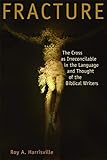Fracture : the cross as irreconcilable in the language and thought of the biblical writers / Roy A. Harrisville. [print]
Material type: TextPublication details: Grand Rapids, Michigan : William B. Eerdmans Publishing Company, (c)2006.Description: xi, 298 pages ; 23 cmContent type:
TextPublication details: Grand Rapids, Michigan : William B. Eerdmans Publishing Company, (c)2006.Description: xi, 298 pages ; 23 cmContent type: - text
- unmediated
- volume
- 9780802833082
- BT450.H323.F733 2006
- BT450
| Item type | Current library | Collection | Call number | Status | Date due | Barcode | |
|---|---|---|---|---|---|---|---|
 Circulating Book (checkout times vary with patron status)
Circulating Book (checkout times vary with patron status)
|
G. Allen Fleece Library CIRCULATING COLLECTION | Non-fiction | BT450.H377.F733 2006 (Browse shelf(Opens below)) | Available | 31923002041032 |
1. Introduction : -- Textbook history without breaks -- Where revolutions begin -- Polarization -- "Jews demand signs" -- "Greeks desire wisdom" -- "Conversion" or "call" -- Paul -- The evangelists -- The fathers -- A new world -- The convert -- Continuity and contrast -- 2. The death of Jesus in Paul : -- The Old Testament cultic and legal tradition -- Use and fracture of wisdom, sacrifice, and the law -- Use and fracture of apocalyptic -- Use and fracture of stoicism -- Use and fracture of gnosis -- Use and fracture of the pre-pauline Christian tradition -- The pauline experiential theology -- Paul and the cross in the believer's life -- 3. The death of Jesus in Mark : -- The scheme -- Old Testament theology -- Use and fracture of the servant motif -- Use and fracture of apocalyptic -- Use and fracture of the divine man -- Use and fracture of the pre-marcan tradition -- 4. The death of Jesus in Matthew : -- The scheme -- Use and fracture of Old Testament theology and apocalyptic -- Use and fracture of nomism -- 5. The death of Jesus in Luke : -- Luke and the heilsgeschichtlich scheme -- A second reading -- Use : martyrs and wisdom -- Fracture : the divine necessity -- 6. Synoptic confession of the crucified -- 7. The death of Jesus in John : -- The debate -- The scheme -- Use and fracture of Judaism -- Use and fracture of gnosis -- 8. The death of Jesus in Hebrews -- The death of Jesus -- Hebrews and Judaism -- Use and fracture of the cultic -- Use and fracture of apocalyptic -- Use and fracture of hellenistic Bible exegesis -- Use and fracture of gnosis -- 9. The death of Jesus in the First Epistle of Peter -- The independence of the Epistle -- Use and fracture of the Old Testament and Judaism -- Hellenization and its fracture -- Gnosis and its fracture -- Christian sources and their fracture -- 10. Conclusion.
Since the advent of formal biblical criticism, many have come to see the crucifixion as merely one event in the process of religious development. Yet for the New Testament writers it was so much more, representing a radical break that forever affected their perception of God and the world. In this book Roy Harrisville examines the thought worlds of the New Testament writers, showing how the cross fractured their previously held ideas, causing a profound reorientation centered on the story of the cross. Focusing chronologically on Paul, the Synoptic writers, John, and the authors of Hebrews and 1 Peter, Harrisville demonstrates changes in the writers' understanding of sacrifice, law, Hellenism, apocalyptic, and other areas - changes that created the new values of the radically different Christian community. An insightful work of careful critical scholarship, Harrisville's Fracture will appeal to anyone interested in reviewing the New Testament's witness to that which lies at the heart of earliest Christian confession and which has provoked such bitter conflict in history.
COPYRIGHT NOT covered - Click this link to request copyright permission:
COPYRIGHT NOT covered - Click this link to request copyright permission:
There are no comments on this title.
